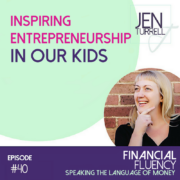Episode #40: Inspiring Entrepreneurship in our Kids
Inspiring Entrepreneurship in our Kids
Hello, and welcome to today’s episode of Financial Fluency. Today I want to talk about inspiring entrepreneurship in our kids, it’s something I’ve written a couple of articles about before. (Here’s one over at Daily Worth).
You can listen in or read below and Tweet it out here
This is something I think is important because of the way that the landscape of the workforce has been changing drastically in recent decades. Whether or not you work for a company, nowadays everyone needs to be a self-starter and everyone needs to look out for their own career.
Long gone are the days of careers of working at the same company for 50 years and retiring with a pension plan. We all know that and yet I think what our kids are learning in school is not necessarily pushing them towards this idea of being self-starters and entrepreneurs. I’m not going to speak for all schools, of course, there are different programs in different areas.
Overall what kids learn in school is to sit quietly, keep their heads down, do their work and not to make any trouble
So what is it that we can do in own our lives to help our kids learn some of these principles of entrepreneurship?
I made up a quick list here that I’d like to share with you and then I’m going to tell you about what I started doing with my own kids to inspire entrepreneurship in them.
1. Goal Setting
The first one I think that is really important is to practice goal setting with your kids and not just setting goals but writing them down.
I’ve seen studies that show that you’re 80% more likely to reach your goals if you actually write them down on a piece of paper. So, work with your kids making some goals, write them down and put them where your kids can see them daily. That way you can talk about them, you can mark progress towards them, you can talk about, “What can we do this week that can help us move further towards our goal?”
2. Opportunity Recognition
The next tip that I wanted to give is encouraging opportunity recognition.
There are a lot of problems in the world. There are a lot of things that come up every day that we can bemoan and feel bad about but a problem is often an opportunity for somebody to find a solution. So, if there’s something that’s come up in your kids’ life that’s difficult.
Maybe there’s a derelict playground near your house or something and it would be a really cool place for the kids to play if only it weren’t so overgrown and messy and had trash all over it. That’s a problem. That’s something that is an unfortunate thing for your kids but what could they do about it?
They could do some fund-raising and have a clean up day. Make it a social good program to involve the whole neighborhood in cleaning up the derelict playground so that all the kids could play again
That’s just one example but pretty much anything that’s going on. Something that’s happening at school, something that’s happening in your local community. You could talk to your kids about what the problem is and brainstorm about what types of solutions could possibly help. Even if it’s not within the scope of your children to fix it, just the idea of, “Oh, okay, so there’s a problem, there’s something that can be done about it. What can we do to make it better?”
3. Money Matters
The third tip I want to give is teaching money matters. A lot of kids don’t get the real experience of controlling money themselves until they maybe hit college and get their first credit card which is a really tough time for a lot of kids.
A lot of kids who are away from home for the first time finally feel some independence and they want to go do fun and exciting things and I experienced this myself when I went to college and got my first credit card. I was going to school with a lot of kids who are in a much higher socio-economic sphere than I was. I’d see them do things like go to Martha’s Vineyard for Spring break and go to the shore and do all these exciting things. Go shopping at very expensive stores.
Because I was at this school with them, I wanted to go along with them and do these different things and I didn’t really understand the difference in my ability to pay back my credit card from theirs ’cause we’re all at the same school together, we’re all doing these things, I wanted to part of the group, a lot of kids do.
I think a way to buffer your children from that experience at college is to start much earlier. Let them earn some money and save money, budget money and spend money much earlier on so that they don’t have to go hog-wild when they hit college and finally get a credit card.
Let them kind of experience what it’s like to really save up for something and pay for it in full rather than always seeing things go on credit cards.
The way that kids see us use money nowadays is a bit problematic too. I’m dealing with this with my own kids because half the time we go to the grocery store, I take out my phone and pay with Apple Pay at the cash register so my kids don’t even see money being exchanged.
They just see that we go to the store, fill up our cart, the shopping gets run through this thing, mom waves her phone and then we go.
So the idea of what things cost, what things are worth, how long we have to work or what kind of work we have to do to get the money in the first place, it can be totally invisible to kids unless we show them what’s going on. We have to peel back that curtain and explain to them how it works.
So I’ve been really making an effort with my kids to do that. We went on vacation recently and as we were coming back my six year old said that she wanted to go on vacation for a hundred days so I was trying to explain to her that mommy and daddy have to work and that we have to work so much so that we can save enough money up to go on vacation ’cause every day that we’re on vacation we’re paying for things, we’re paying for our rental car or our hotel room or the places that we go.
So when we got back, Myffy made up this little calendar. She put a bunch of squares on a piece of paper and wanted to start marking off how long until we could go back on vacation again. Then there were times where she even said, “Mommy, do you need to work on your computer so you can make money to go on vacation?” I was like, “Okay, yeah, we’re starting to make the associations that there are some exchanges going on here.” So I was very proud of her for that. Obviously, we don’t want to overburden or overstress our kids with our financial situations but at least, letting them see some of how it works, I think is really important for them.
4. Failure is a Teacher
Another tip that I wanted to bring up is to show them that failure is a teacher and that it’s not an end. It’s not a destination and this is something that I do see as problematic with schools is, when you have a test, you either pass it or you fail it.
If you fail it, what happens? It seems like an end a lot of times for kids. It seems like, “Oh, okay, you fail. If you fail completely, you get held back and you have to do that whole year again.” Failure is just a really bad thing rather than something that you learn from. So showing kids that when something doesn’t work out, how to go back and analyze the results. “Okay, so this didn’t work the way we wanted it to work, what could we have done different, what could we do different next time that could influence the outcome?”
I feel like good schools and good teachers do do that with kids, they do go back and work through the problems that were missed and figure out what was wrong and allow them to retake the test and allow them to then succeed based on what they learned from that failure but I don’t know that overall the school system is really great at that.
5. Communication is Key
Practice communication skills with your kids and by this, I mean talking about a wide variety of subjects. Talking about things that are going on around them in your community, online, on TV, the things that they see. Don’t shut them down, don’t shut down questions because you don’t think they’re old enough to discuss it.
If they aren’t old enough to discuss it, discuss why that is, why this is something that maybe they don’t need to learn about right now but engage in the conversation with them. Really help them see the back and forth of conversation.
With technology intervening in so much of the communication that we do today, I think it’s really easy to not get into those deep conversations with people on a daily basis and I think it’s important for our kids to learn how to do that.
It’s important for them to talk to people in a way that allows them to see what’s important to the other person and allows them to communicate what’s important to them to that other person as well. So really taking the time to have these conversations with your kids, not just about the big, important things but about the little trivial things too. Just, “So why do you think that is? Why do you think that is? Well, what do you think about that?” Just really digging in and finding out what’s going on in their minds.
I am often fascinated especially my six-year-old Myffy, the way her brain makes connections between things is often really surprising to me. I feel like she thinks about things in a very different way than I do. So we both learn a lot when we take the time to have these conversations.
6. Instill Independence
Now this can be hard for the parents of small children. The toddler years are where they start finding independence and it can often bring us to loggerheads with our kids.
A thing needs to happen. The child absolutely does not want to do this thing. What do we do? I think that as much as possible, whenever we’re able to, allow your child to go ahead and try something even if you can see that it’s not going to quite work out the way that they wanted to.
Allow them to have that experience. Be there to help them, to pick them up if they fall down and all of that but really giving them the chance to try out their own ideas and then if they need some help making a pivot or making an adjustment figuring out what’s wrong, help them but let them have the experience, not always jump in and stop it just because you can see what’s going to come next because having that experience will help them be able to see in the future what you can see now for them.
7. Introducing sales situations
This tip is a little bit of an odd one because we don’t think of introducing sales situations to little children very often. If anything, we probably avoid introducing our children to sales situations but it’s a huge part of life.
Bringing into the conversation during buying things like, “So, what is it that made you want to buy that toy? Why do you think that appealed to you so much? If you were going to sell that toy to another kid, what would you say about it?” When they do want to sell things, if your child does want to make pocket money other than doing chores at home and things like that, really talk to them about how they’re going to present their sales.
If they’re going to do a lemonade stand, “How do you want to describe it? Do you want to have something else too? Do you want it to be ice cold? Do you want to put an umbrella in it? How can we make it more appealing to people? What would people really want with this lemonade? Should we have cookies as well? What kind of cookies? Do people really like Girl Scout cookies? Do we have Girl Scout cookies right now?” Just kind of discussing options, looking at how this exchange happens.
If your child wants to be able to have some money for certain things, what do they need to do in order to get it in an authentic and legal and positive way, like making sales situations a positive experience for your child, rather than something that can be mortifying?
8. & 9. Start Early and Have FUN!
The last two things I want to say are just to start as early as possible. Start implementing these different tips as you can and have fun with it.
Figure out ways to make looking at solving problems, coming up with solutions, selling things to the people who want them as something fun that you can do with your kid. Also, the money side of it too. It’s really exciting for kids to realize that there are ways that they can earn money and speaking of which, this brings me into my new project with my kids which I wanted to tell you about.
So, my youngest, Myffy, who’s six years old, for a while she’s been telling us that she is an artist and an illustrator like a friend of ours and I’ve been saying, “Yes, of course, you can be an artist and an illustrator, you can be anything that you want to be.” But obviously, in my mind, I’m thinking, “You can be an artist and an illustrator in 10 or 15 or 20 years after going to Art School.” What she means is she’s an artist and an illustrator right now and I finally thought,
Why should she have to wait 10 or 15 years to feel like she’s an artist? She does Art every single day
So does Tallulah, my oldest. So, I decided to go and set up a Redbubble site for them.
Now, Redbubble is a low barrier to entry kind of website, where artists upload their Art and it’s totally free for the artists and then what they do is they take those designs and they do print on demand on a variety of different products so you can get t-shirts or mugs, pillows, notebooks, all kinds of things. Greeting cards, stickers.
So I uploaded a few designs for each kid and I put them on there and we set it up and I announced it to my friends and family and they immediately had six or seven sales and it was super exciting for them and I can’t wait for Myffy in particular, to see two of our friends who recently got married. They each ordered a t-shirt with the design called, “Let’s get married” that she drew of a bride and groom on the t-shirt.
So, what that did for them was they now, really can see themselves as artists. They have artwork out there in the world that someone has paid to own, in some way. The profit margin for the artist is relatively small because Redbubble takes care of all the ordering, payment, printing, manufacturing, shipping fulfillment and Customer Service.
So at most, the kids are going to get about 20%, so those t-shirts were roughly $20 each. Myffy gets roughly $4 so that’s about $8 for those t-shirts our friends bought. I think the total we’re up to is about $18 or something in profit. But still, that’s exciting for a six and an eight-year-old, that’s a start and we can go in there anytime they want, we can upload some new designs, we can send it out to our mailing list of family and friends and it’s really exciting for them.
So if your kids are artists, want to be artists, want to be artists now, not just when they grow up, this might be a good option for you too. Check out my kids’ website. You can see what they’re doing and if you want to support some burgeoning artists/entrepreneurs, you can buy some stuff from them if you want.
So thank you so much for joining me for this episode today. I was really excited to talk about this. It’s something very close to my heart.
If you enjoyed this episode you can subscribe to Financial Fluency here on iTunes and listen every week. If you like what you hear, please also leave an awesome iTunes review
I do two episodes every week, one solo and one interview.
I also have the fantastic Mastering Money Matters group, a monthly membership group where you can join and we talk about all the different pieces week by week of getting our money systems set up and how we look at, think about and value money and all areas of our lives.
It’s a very supportive and private group just for women and it’s a safe place to hang out and talk. It’s kind of the extension of the interviews I’ve been doing with mainly entrepreneurs on this show, and it’s where we can talk about the things we may not want to broadcast out to a broader audience.
Let’s Keep the Conversation Going
If you’re enjoying the podcasts and something has lit a fire for you, carry on the conversation over on the Financial Fluency Facebook Group.
See you there!
Jen x










Leave a Reply
Want to join the discussion?Feel free to contribute!